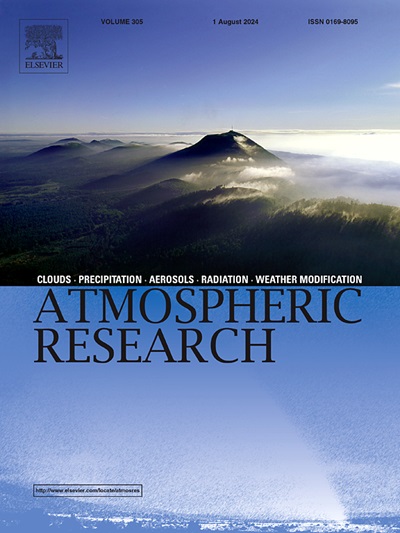Numeral simulation of impacts of sea land breeze on the formation and dissipation of the Bohai Sea fog
IF 4.5
2区 地球科学
Q1 METEOROLOGY & ATMOSPHERIC SCIENCES
引用次数: 0
Abstract
From 2019 to 2022, there were a total of 34 sea fog events in the Bohai Sea, among which sea land breezes (SLB) occurred 17 times (accounting for 50 %). The duration of fog in the presence of SLB ranged from 24 to 40 h, while fog without SLB lasted between 3 and 7 h. The SLB circulation significantly increased the duration of sea fog. Therefore it's necessity to study the impacts of SLB on fog formation and dissipation of the Bohai Sea. The Weather Research and Forecasting (WRF) model could simulate meteorological elements well, showing good reliability. Sensitivity experiments were carried out using the WRF model on two different types of SLB-fog. The numeral simulation results are showed as follows. Under the influence of land breeze, the vertical cloud liquid water (CLW) content increased 0.016–0.7 g kg−1, the height of the boundary layer reduced 66.7 % ∼ 92.3 %, and temperature inversion layer was formed 0.5 km in the coastal and offshore areas of the Bohai Sea. Thus the sea fog was formed and the coastal fog intensity was enhanced affected by the land breeze. Under the influence of sea breeze, the height of the boundary layer increased 0.5–7 times and the temperature inversion layer disappeared or weakened in coastal cities. The influence of sea breeze on the transportation of CLW content was decreased 0.016–0.358 g kg−1. Under the combined influence of factors such as CLW, temperature inversion, and boundary layer height, the sea breeze caused large-scale dissipation of sea fog in the Bohai Sea or hindered the expansion of the fog area. Numeral simulation of a typical case indicated that the increased CLW content (0.016–0.07 g kg−1) under the influence of land breeze led to the formation of this sea fog. The intensity of the land breeze influenced the size of the fog area. In the near-surface layer of A Platform, the Richardson number (Ri) decreased 0.2–7.2 when affected by the sea breeze, which was conducive to the development of turbulence. The CLW content decreased by up to 0.71 g kg−1. Therefore, the sea fog dissipated over a large area in the Bohai Sea under the influence of sea breeze. These findings suggest that the mesoscale circulation of SLB played an important role when the large-scale meteorological conditions were relatively weak.
海陆风对渤海雾形成和消散影响的数值模拟
2019 - 2022年,渤海共发生海雾事件34次,其中海陆风17次(占50%)。有SLB时雾的持续时间为24 ~ 40 h,无SLB时雾的持续时间为3 ~ 7 h。SLB环流显著增加了海雾的持续时间。因此,有必要研究薄冰对渤海雾的形成和消散的影响。气象研究与预报(WRF)模式能较好地模拟气象要素,具有较好的可靠性。利用WRF模型对两种不同类型的slb雾进行了灵敏度实验。数值模拟结果如下:在陆风影响下,垂直云液态水(CLW)含量增加0.016 ~ 0.7 g kg−1,边界层高度降低66.7% ~ 92.3%,在渤海近岸地区0.5 km处形成逆温层。因此形成了海雾,并在陆风的影响下增强了沿海雾的强度。海风影响下,沿海城市边界层高度增加0.5 ~ 7倍,逆温层消失或减弱。海风对CLW含量输送的影响降低0.016 ~ 0.358 g kg−1。在CLW、逆温、边界层高度等因素的综合作用下,海风导致渤海海雾大规模消散或阻碍雾区扩大。典型案例的数值模拟表明,陆风作用下CLW含量的增加(0.016 ~ 0.07 g kg−1)导致了海雾的形成。陆风的强度影响雾区的大小。A平台近地面层受海风影响理查德森数(Ri)减小0.2 ~ 7.2,有利于湍流的发展。CLW含量降低了0.71 g kg−1。因此,在海风的影响下,渤海海域的海雾大面积消散。这些结果表明,当大尺度气象条件相对较弱时,低气压中尺度环流发挥了重要作用。
本文章由计算机程序翻译,如有差异,请以英文原文为准。
求助全文
约1分钟内获得全文
求助全文
来源期刊

Atmospheric Research
地学-气象与大气科学
CiteScore
9.40
自引率
10.90%
发文量
460
审稿时长
47 days
期刊介绍:
The journal publishes scientific papers (research papers, review articles, letters and notes) dealing with the part of the atmosphere where meteorological events occur. Attention is given to all processes extending from the earth surface to the tropopause, but special emphasis continues to be devoted to the physics of clouds, mesoscale meteorology and air pollution, i.e. atmospheric aerosols; microphysical processes; cloud dynamics and thermodynamics; numerical simulation, climatology, climate change and weather modification.
 求助内容:
求助内容: 应助结果提醒方式:
应助结果提醒方式:


